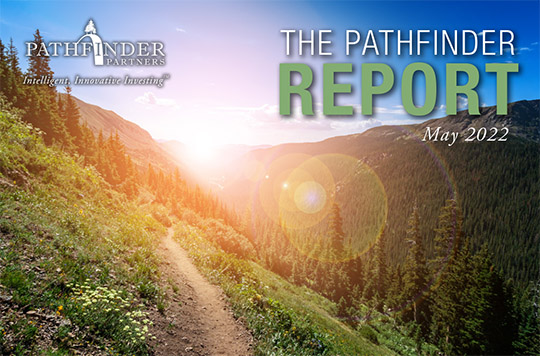Charting the Course
The Fed is Between a Rock and Very Hard Place
By Mitch Siegler, Senior Managing Director
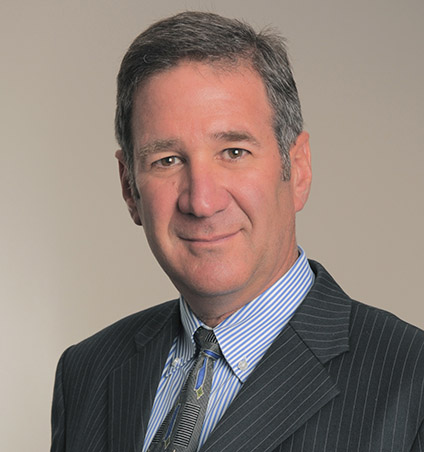
Mark Twain said that history doesn’t repeat itself but that it often rhymes. Is it just us or are red-hot inflation, surging gasoline prices and rising interest rates making it feel like the 1970s again? The last time prices were rising this fast, gas lines and double-digit interest rates abounded, men sported lambchop sideburns and leisure suits, women wore pantsuits and platform shoes, and hula hoops and pet rocks were all the rage. Who wants to return to that?
Surprise, Surprise, Surprise
When the pandemic hit in March 2020, the Fed founded itself in uncharted territory and bobbed and weaved well. During the past year, the Fed has been slow to act, even a bit complacent. Last April, the Fed dubbed inflation “transitory”, messaging which continued until December. Most grocery shoppers or owners of cars with internal combustion engines would have said ‘it just ain’t so’.
On April 29, there was an astonishing economic announcement. That day, we learned that Gross Domestic Product (GDP) growth didn’t just slow in the first quarter of 2022; GDP shrank -0.4% or at an annualized rate of -1.6%. Another quarter like this, say economists, and we’re officially in a recession.
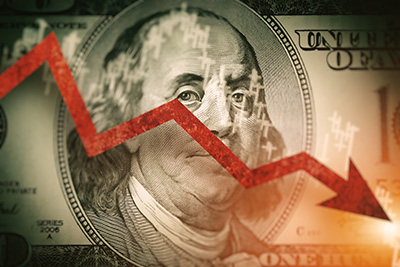 Now, very few experts saw that one coming. Most economic forecasts called for 1% quarterly (4% annual) economic growth – not a 1.6% decline. And that decline was before the supply shocks from China’s latest Covid-zero shutdowns, the pain still to come from Russia’s Ukraine invasion-induced oil price shock and a notable slowdown in consumer spending, as higher prices and interest rates bite average Americans. Going out on a limb, the portents for second quarter economic growth may not be super-duper.
Now, very few experts saw that one coming. Most economic forecasts called for 1% quarterly (4% annual) economic growth – not a 1.6% decline. And that decline was before the supply shocks from China’s latest Covid-zero shutdowns, the pain still to come from Russia’s Ukraine invasion-induced oil price shock and a notable slowdown in consumer spending, as higher prices and interest rates bite average Americans. Going out on a limb, the portents for second quarter economic growth may not be super-duper.
Let’s put the first quarter economic slowdown into perspective. Growth in the December quarter was 1.7% – an annualized rate of 6.8%. That’s an order of magnitude higher than the trend line for economic growth during the past decade and it’s simply not sustainable. A single quarter does not make a trend make but the dramatic and rapid slowdown is extraordinary. When you combine slow growth with the highest inflation in 40 years, it starts to feel like stagflation. The ‘70s again.
What Goes Up…Must Come Down…
Think about the massive economic stimulus of the past couple of years like flooring your car’s accelerator. To slow the economy and squelch inflation, the Fed will need to tap on (or slam?) the brakes. Optimists at the Fed and in the Administration have been hoping to thread the needle by easing up interest rates without tipping the economy into a recession – the elusive “soft landing”. The Fed’s track record in engineering soft landings is not stellar. The hope, as usual, is that this time will be different.
In late 2021, the consensus thinking was that three or four 25-basis point increases in interest rates would do the trick. Now, the consensus is to prepare for three 50-basis point increases by July with several more 25-basis point bumps in the fall. The first 50-basis point increase was announced on May 4. (The Fed hasn’t boosted rates by 50 basis points since 2000. A basis point is 1/100 of a percentage point.)
The Fed also has $9 trillion in mortgage-backed and Treasury securities on its balance sheet, much of which will be sold in the months and years ahead. In its May 4 announcement, the Fed committed to selling $47 billion per month through August and $95 billion per month thereafter. Shrinking the Fed’s balance sheet will also hit financial markets. J.P. Morgan forecasts $1.1 trillion in bond sales this year; its derivatives team thinks four years of bond sales are equivalent to another 210 basis points in interest rate hikes. Is that the smell of burning brake pads?
A ‘70s Perspective
Economists believe the Fed’s benchmark rate – the Fed Funds rate – would need to rise to about 3% to reach the “neutral” level, where it is neither stimulating nor restraining growth. If inflation has really peaked, that might get the job done. But many believe inflation will prove sticky and higher (much higher?) interest rates may be needed to squash rising prices. When he was appointed Fed Chair in 1979, Paul Volker was forced to take very tough measures to tamp down inflation because it was allowed to simmer for so long. Under Volker, the Fed Funds rates peaked at 20%.
This Fed, under Chair Jay Powell, has taken a measured approach. The Fed’s jawboning has already generated a major reaction in financial markets. The 10-year Treasury rate, 1.5% at the end of 2021, has moved above 3.0% in four months. As the futures market is anticipating a 3.0% Fed Funds rate by year-end (up from 0.75% to 1.00% today), the 10-year Treasury could exceed 5.0% by December.
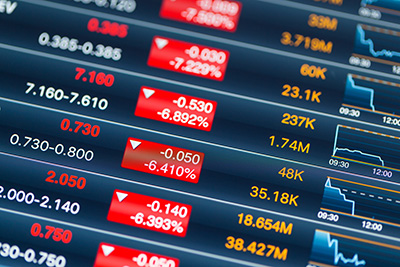 This speed and magnitude of interest rate increases have spooked investors. Stock prices have fallen sharply this year with the S&P 500 down 12.5% and the tech-heavy NASDAQ down 20% in the four months through April. There’s been further pain for stock investors in the wake of the Fed’s May 4 interest rate announcement. The monthly mortgage payment required to purchase a median-priced home has increased 45% in the past year, from $1,165 to $1,690, according to investment bank Piper Sandler. Both the equity and housing markets are cooling. Rising prices, slowing growth and declining asset values – the ‘70s again.
This speed and magnitude of interest rate increases have spooked investors. Stock prices have fallen sharply this year with the S&P 500 down 12.5% and the tech-heavy NASDAQ down 20% in the four months through April. There’s been further pain for stock investors in the wake of the Fed’s May 4 interest rate announcement. The monthly mortgage payment required to purchase a median-priced home has increased 45% in the past year, from $1,165 to $1,690, according to investment bank Piper Sandler. Both the equity and housing markets are cooling. Rising prices, slowing growth and declining asset values – the ‘70s again.
Two Key Questions for the Fed: Has Inflation Peaked and Are Supply Shortages Easing?
The Central Bank’s moves to boost interest rates will curb demand. However, supply chains operate largely independently. Whatever actions the Fed takes to raise interest rates or sell securities won’t change labor force participation, factory output, container ship capacity, truck driver availability or the myriad other factors crimping the supply side.
Fed hawks agonize over the fact that the central bank has been slow to acknowledge the severity of supply chain and labor shortages which led to price spikes and smoldering, unsustainably high inflation rates. Fed doves argue that inflation, which was running above 8% in March compared with the prior year, has peaked and should be far lower later this year. We’ll remind you that these are some of the same folks who characterized inflation as “transitory” as late as December 2021 and fear that this ‘go slow’ approach may be wishful thinking. Count us in the camp which believes that beating back inflation will require aggressive monetary policy and a soft landing may no longer be in the cards.
Historically, half measures by the Fed haven’t solved the problem of rising prices. When the Fed moves too little or too slowly, it’s like a patient taking just half of the doctor’s required antibiotic dosage or only taking the medicine for a portion of the recommended time; the bacteria multiplies and the infection is more difficult to beat back later.
So, How to Read the Tea Leaves?
On the surface, economic growth still looks solid. Peel back the onion, though and you see negative first quarter GDP and declining wages on an inflation-adjusted basis. Also, consumers’ stimulus checks from 2020-2021 have been largely spent so the savings that could cushion a slowdown aren’t what they were. Both retail spending and the producer price index for private capital equipment, while strong on the surface, have been flat or negative when adjusted for inflation.
The housing market, a bright spot in the economy, accounts for about 20% of GDP and 40% of the consumer price index (CPI). Homebuyers are now staring at rates averaging 5.5% for 30-year, fixed-rate, conforming mortgages, up from 3.1% in early January. While that’s a far cry from the mid-teens rates of the 1970s, it’s well above the 2.5% to 3.0% mortgages of the past few years. Mortgage rates could top 7.0% by year-end if forecasts for Fed moves hold. That will surely slow home price appreciation, but home prices will likely remain elevated given the shortage of inventory (reflected in the 15.7% year-over-year home price appreciation in the first quarter). High home prices and mortgage rates crimp homebuying and we don’t think the Fed can fundamentally slow the economy without also cooling the housing market. Fed moves to sell its mortgage-backed securities will put additional pressure on mortgage rates and payments.
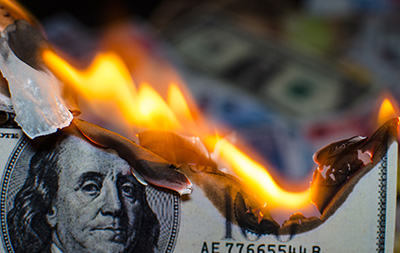 Another consideration is the increasing cost of new home construction, up 25% to 30% in many markets. Homebuilders report that just a small portion of these higher costs have been passed along to homebuyers though that’s begun to change, and consumers are preparing for higher new home prices as a result. As home prices and mortgage rates rise, more potential homebuyers shift to rentals, boosting demand for apartments and driving rents higher. All told, higher home prices, mortgages and rents add fuel to the inflation fire.
Another consideration is the increasing cost of new home construction, up 25% to 30% in many markets. Homebuilders report that just a small portion of these higher costs have been passed along to homebuyers though that’s begun to change, and consumers are preparing for higher new home prices as a result. As home prices and mortgage rates rise, more potential homebuyers shift to rentals, boosting demand for apartments and driving rents higher. All told, higher home prices, mortgages and rents add fuel to the inflation fire.
Conventional wisdom sees the Fed slowing the economy without causing a recession. A few contrarians think the Fed has waited too long to move and there’s now too much money sloshing around to soak up quickly. Deutsche Bank, the first major bank to predict a recession, believes the Fed is in a tough spot and we’re not only looking at a recession but a severe downturn. The bank’s chief economist, David Folkerts-Landau says “there are good reasons to expect inflation will continue to surprise to the upside…we regard it as highly likely that the Fed will have to step on the brakes even more firmly and a deeper recession will be needed to bring inflation to heel.” He forecasts a 5% to 6% peak in the Fed Funds rate next year (which would impute a 7% to 8% rate on 10-year Treasuries and double-digit 30-year, fixed rate mortgage rates). That’s about double the consensus view. Deutsche Bank thinks there are risks to its forecast and rates could end up at much higher levels if all doesn’t go smoothly.
We’ve spent many years in the trenches of the housing market and written for more than a year about the folly of the Fed’s “transitory” inflation talk. As such, it’s hard to be too ebullient about the Fed’s prospects for threading the needle and we remain skeptical of the peak-inflation (and soft landing) arguments. Rents, a significant component of the CPI, generally lag home prices by 12 to 18 months. Market rents ended 2021 up 13.5% from a year earlier and many tenants haven’t yet seen the full impact of the tighter housing market. Rents will likely be higher in December than now in any case. Upward pressures on rents will remain as both new and resale homes become less affordable, and even more people shift to renting. And don’t expect substantial new supply of apartments to solve the problem; rising construction costs puts ever more pressure on the supply side. The housing supply/demand imbalance continues. That’s reason #72 why we remain bullish about the multifamily housing sector.
Mitch Siegler is Senior Managing Director of Pathfinder Partners. Prior to co-founding Pathfinder in 2006, Mitch founded and served as CEO of several companies and was a partner with an investment banking and venture capital firm. He can be reached at msiegler@pathfinderfunds.com.
Share this Article
IN THIS ISSUE
PATHFINDER PARTNERS INCOME FUND, L.P.
A Stablized Multifamily Fund
CHARTING THE COURSE
The Fed is Between a Rock and a Very Hard Place
FINDING YOUR PATH
Rooting for the Underdog
GUEST FEATURE
Stopping Hackers in Their Tracks: How You Can Stay Vigilant to Guard Against Cyber Threats
ZEITGEIST
Sign of the Times
TRAILBLAZING
FortyOne 11, Portland, OR
NOTABLES AND QUOTABLES
Inflation
